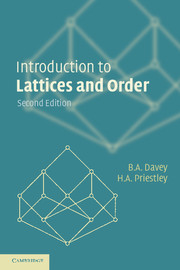Book contents
- Frontmatter
- Contents
- Preface to the second edition
- Preface to the first edition
- 1 Ordered sets
- 2 Lattices and complete lattices
- 3 Formal concept analysis
- 4 Modular, distributive and Boolean lattices
- 5 Representation: the finite case
- 6 Congruences
- 7 Complete lattices and Galois connections
- 8 CPOs and fixpoint theorems
- 9 Domains and information systems
- 10 Maximality principles
- 11 Representation: the general case
- Appendix A: a topological toolkit
- Appendix B: further reading
- Notation index
- Index
4 - Modular, distributive and Boolean lattices
Published online by Cambridge University Press: 05 June 2012
- Frontmatter
- Contents
- Preface to the second edition
- Preface to the first edition
- 1 Ordered sets
- 2 Lattices and complete lattices
- 3 Formal concept analysis
- 4 Modular, distributive and Boolean lattices
- 5 Representation: the finite case
- 6 Congruences
- 7 Complete lattices and Galois connections
- 8 CPOs and fixpoint theorems
- 9 Domains and information systems
- 10 Maximality principles
- 11 Representation: the general case
- Appendix A: a topological toolkit
- Appendix B: further reading
- Notation index
- Index
Summary
In Chapter 2 we began an exploration of the algebraic theory of lattices, armed with enough axioms on ∨ and ∧ to ensure that each lattice 〈L; ∨, ∧〉 arose from a lattice 〈L;≤〉 and vice versa. Now we introduce identities linking join and meet which are not implied by the laws (L1)–(L4) and their duals (L1)∂–(L4)∂ defining lattices (recall 2.9). These hold in many of our examples of lattices, in particular in powersets. In the second part of the chapter we abstract a different feature of powersets, namely the existence of complements.
Lattices satisfying additional identities
Before formally introducing modular and distributive lattices we prove three lemmas which will put the definitions in 4.4 into perspective. The import of these lemmas is discussed in 4.5.
Lemma.Let L be a lattice and let a,b,c ∈ L. Then
(i) a ∧ (b ∨ c) ≥ (a ∧ b) ∨ (a ∧ c), and dually,
(ii) a ≥ c implies a ∧ (b ∨ c) ≥ (a ∧ b) ∨ c, and dually,
(iii) (a ∧ b) ∨ (c) ∨ c) ∧ (a) ≤ (a ∨ b) ∧ (b ∨ c) ∧ (c ∨ a).
Proof. We leave (i) and (iii) as exercises. (Alternatively, see Exercise 2.9.) By the Connecting Lemma, (ii) is a special case of (i).
- Type
- Chapter
- Information
- Introduction to Lattices and Order , pp. 85 - 111Publisher: Cambridge University PressPrint publication year: 2002



